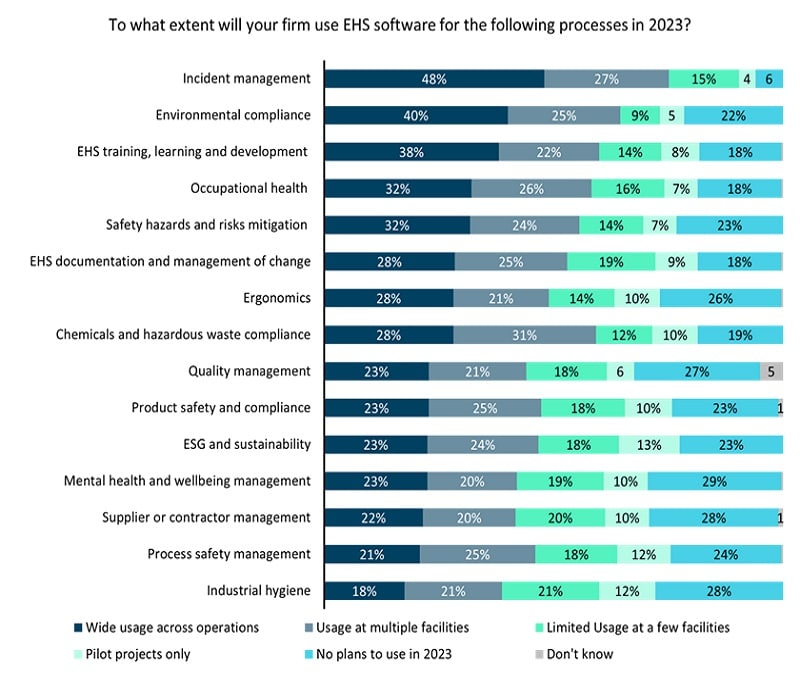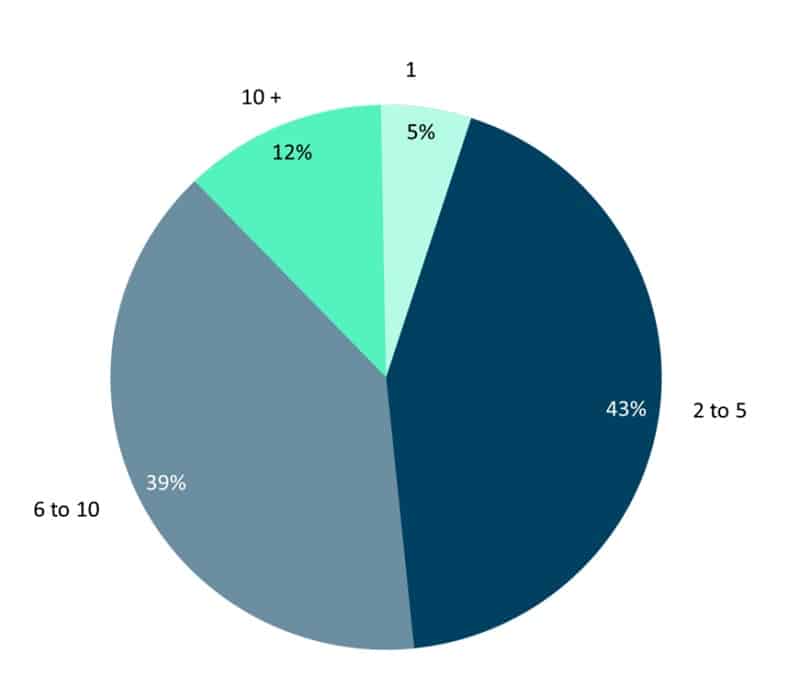Overcoming the Challenges of Scaling an HSE System Across Your Organisation
Overcoming the Challenges of Scaling an HSE System Across Your Organisation

Scaling Health, Safety, and Environment (HSE) software across your organisation might feel like a daunting task. Before you begin, it is essential to identify the challenges you might encounter and create a solid plan. That is where our HSE solutions (provided by TenForce, an Elisa IndustrIQ company) comes in. We have created this useful guide to help you navigate the scaling process.
In this article, we will share valuable industry insights, discuss the risks and challenges of scaling, offer practical tips to overcome them, and shed light on the benefits that scaling can bring.
Unveiling the Challenge: Insights from 300+ HSE Leaders Reveals Inefficient EHSQ Software Utilisation
A recent global survey of 300+ EHS leaders conducted by Verdantix, reveals eye-opening insights into how companies are utilising HSE software.
Looking at the chart to the right, it reveals a gap between corporate aspirations to digitalise HSE processes and the actual provision of software to their employees. The survey uncovers that, aside from a handful of essential modules, most companies have struggled, stalled, or even failed to fully digitalise HSE processes across their entire business.
One of the main reasons behind this implementation gap is the complex nature of HSE software rollouts. Many companies find themselves stuck in a perpetual loop of global rollouts, which is an incredibly time-consuming journey for everyone involved.

Source: Verdantix Global Corporate Survey 2022: EHS Budgets, Priorities & Tech Preferences

Source: Verdantix Global Corporate Survey 2022: EHS Budgets, Priorities & Tech Preferences
Deriving from the pie chart on the left, it is clear that a majority of survey respondents, over half of them, are juggling six or more software solutions to manage their HSE programs. Companies handpick modules from various vendors, each with their own unique strengths, and then blend them into one massive project. Unfortunately, this approach often leads to inefficiencies within the business.
Using multiple systems is a symptom of organisations facing obstacles to scale HSE software across their entire operation. Rather than having a streamlined approach, they rely on legacy systems confined to specific jurisdictions or hastily implement single modules as temporary solutions during a broader implementation process. The result? These individual systems exist in isolated silos, each with different workflows, interfaces, and inconsistent outputs.
It is clear that there is room for improvement when it comes to integrating HSE software seamlessly across an organisation. Rest assured, there are solutions to help you navigate these challenges and achieve a more unified and efficient approach to HSE management.
From Fragmented to Integrated: Six Benefits of Consolidated HSE Systems
When manufacturers depend on a fragmented assortment of HSE software systems, they inadvertently overlook the potential benefits of an efficient and consolidated solution. Let’s explore some of these advantages:
• Centralized HSE data: Consolidate your HSE software into one comprehensive system to have all your data in a single location. This makes it easier to access, manage, and analyse information related to environmental, health, safety, (and quality) processes throughout your organization.
• Improved data analysis: Harness the power of robust data analysis tools with a consolidated HSE system. Extract valuable insights and trends from your data, enabling better decision-making, proactive risk mitigation, and identification of areas for continuous improvement.
• Avoiding duplicated work efforts: Consolidating your HSE processes eliminates duplicated efforts such as entering the same data multiple times or manually transferring information between systems. Save time and reduce the risk of errors by streamlining your EHS workflows.
• More appealing to IT functions: Optimise efficiency and reduce complexity by allowing your IT department to focus on maintaining and optimising a single platform instead of managing and supporting multiple systems.
• Workflow consistency: Standardise workflows and processes across your organisation. Ensure consistency in task execution, data capture, and compliance requirements while promoting collaboration and knowledge sharing among teams and locations.
• Lower subscription costs: Cut down on expenses associated with licensing and maintenance by consolidating your HSE software. Get rid of multiple software subscriptions and streamline your costs.
To fully take advantage of these benefits, organisations should consider implementing an all-in-one HSE software solution that can be seamlessly scaled across their entire organisation. This approach maximises the advantages above whilst promoting efficiency, standardization, and a holistic view of your HSE programs.
Key Factors for Scaling Your HSE System Across the Organisation
To successfully scale your HSE system, there are a few important factors and considerations to keep in mind:
• Finding the right balance between flexibility and standardisation
It is a delicate balance between allowing separate entities, departments, and personnel within your organisation to fulfil their unique EHS needs, while also ensuring global EHS reporting requirements are met. A configurable solution can be your best friend in striking the balance.
• Usability of the software
Be sure to invest in making the software as user-friendly as possible by engaging with your employees and gathering their feedback throughout the rollout. By considering their language needs, cultural requirements, and individual preferences, you ensure the software system works effectively for them.

At the end of the day, successful scaling is a team effort. Together, you are able to navigate the challenges, fine-tune the system, and create an environment where your employees can thrive while using the software to its fullest potential.

HSE Software Scaling Gone Wrong: Lessons from a Real-World HSE Software Case Study
Verdantix provides a prime example of a large company that invested heavily in HSE software development. However, their scaling process was disjointed, resulting in poor decisions and lack of foresight. Stakeholders took modules in different directions, leading to over-customisation and compromised system integrity. This caused inconsistent outputs, lack of integration opportunities, and inconsistencies throughout workflows and data.
The consequences of these mistakes were significant:
1. Users struggled with confused processes and lack of uniformity, ultimately abandoning the system.
2. Incorrect or missing data made it challenging for HSE managers to collect and analyse information.
3. Over-customisation resulted in technical errors and increased IT workload.
The organisation’s lack of a clear vision and consideration of the bigger picture caused data and modules to remain siloed. User engagement plummeted, and integration with an active directory was abandoned due to system compromise. Unfortunately, such inefficiencies often lead companies to lose faith in the system, opting to abandon it or revert to manual spreadsheets. These decisions are costly, considering the time, effort, and money invested.
The key takeaway is clear: to truly benefit from scaling HSE software, careful planning and preparation are essential.

The Key to Global Scaling Success: Engaging Your Project Teams
When it comes to scaling and implementing your HSE software, one of the biggest factors for success is the involvement of your project teams. Their leadership and accountability will play a significant role in driving the effectiveness of your implementation efforts.
Another crucial aspect is having a well-defined rollout plan and clear strategy for driving adoption across different geographic units and teams. Collaborating with your software vendor can help determine the priority of module implementations, ensuring they align with your goals.
By fostering collaboration, prioritising involvement, and maintaining open communication, you can set the stage for a successful scaling journey.
From Little Acorns Mighty Oaks Grow: Scaling Your HSE Software with Confidence
When it comes to the planning and kickstarting phase of your scaling project, it is essential to approach it as a transformative journey.
Consider starting with a phased approach. Begin with “phase zero” where you identify a process that will deliver significant value early on. Achieving tangible results as soon as possible creates motivation, triggers engagement and maintains momentum.
By starting small, you will deliver quicker results and gain progressive insights along the way. Implementation often unveils new learnings ang incorporating these insights promptly gives you the ability to pivot swiftly to ensure continuous improvement.

Another key aspect is prioritising training. While it is often viewed as a final step, early training empowers you to fully leverage the platform’s capabilities from the outset. Make sure to provide comprehensive training to key stakeholders, users, and project teams. Investing in thorough training minimises frustration and prevents potential roadblocks. Remember, this journey is about continuous learning, adaptation, and collaboration.
From Data to Growth: Measuring a Successful Scaling Effort
Once you have completed your planning and scaling efforts, it is time to measure your success, and there are a few ways to do it. One way is by counting the number of items you have created. The more data, input, and action items you have, the more you and your team are utilising the software.
From a global perspective, you should see the software growing geographically or in the number of users with better-aggregated reporting. Your software should allow you to easily generate reports across different units or sites.
By keeping track of this aggregation, you can see how your scaling efforts are paying off. As you continue to expand and add more modules, processes, users, or units, you will know that you are on the right track for effective scaling.

How We Help Our Customers Scale
Providing scalable and innovate HSE software through TenForce, we are able to offer our customers an all-in-one platform that brings a range of benefits. It combines user-friendliness with modularity, making it easy to adopt multiple modules. Our suggestion? Start small and smart. We recommend beginning with just one to three modules across two to three sites. This focused approach gives you enough to focus on without overwhelming you, while also providing us with a broader understanding of your company’s needs. By starting small you will set the stage for a successful rollout and pave the way for future scaling opportunities.
If you would like to know more about how you can unlock the full potential of our HSE platform, watch the webinar Scaling an EHS System Across the Organization provided by TenForce.
Receive all updates, news and resources about HSE directly in your inbox. subscribe >
